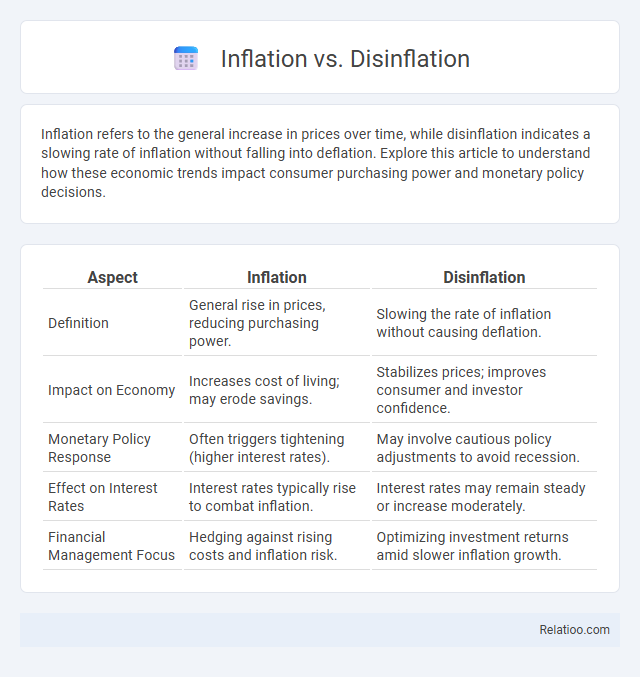Inflation refers to the general increase in prices over time, while disinflation indicates a slowing rate of inflation without falling into deflation. Explore this article to understand how these economic trends impact consumer purchasing power and monetary policy decisions.
Table of Comparison
| Aspect | Inflation | Disinflation |
|---|---|---|
| Definition | General rise in prices, reducing purchasing power. | Slowing the rate of inflation without causing deflation. |
| Impact on Economy | Increases cost of living; may erode savings. | Stabilizes prices; improves consumer and investor confidence. |
| Monetary Policy Response | Often triggers tightening (higher interest rates). | May involve cautious policy adjustments to avoid recession. |
| Effect on Interest Rates | Interest rates typically rise to combat inflation. | Interest rates may remain steady or increase moderately. |
| Financial Management Focus | Hedging against rising costs and inflation risk. | Optimizing investment returns amid slower inflation growth. |
Understanding Inflation: Definition and Causes
Inflation refers to the sustained increase in the general price level of goods and services, reducing your purchasing power over time. Disinflation is the slowdown in the rate of inflation, indicating prices are rising but at a decreasing pace, while deflation means an overall decline in prices. Understanding inflation involves recognizing factors such as demand-pull inflation caused by high consumer demand, cost-push inflation driven by rising production costs, and built-in inflation linked to adaptive expectations.
What is Disinflation? Key Concepts Explained
Disinflation refers to a slowdown in the rate of inflation, where prices continue to rise but at a slower pace than before. Unlike deflation, which signifies a decrease in overall price levels, disinflation indicates that inflation is still positive but diminishing. Understanding disinflation helps you anticipate changes in purchasing power and make informed financial decisions during fluctuating economic conditions.
Core Differences Between Inflation and Disinflation
Inflation refers to the sustained increase in the general price level of goods and services, leading to decreased purchasing power over time. Disinflation describes a slowdown in the rate of inflation, where prices continue to rise but at a slower pace than before, indicating a moderation rather than a reversal in price growth. The core difference lies in inflation reflecting rising prices while disinflation signals a reduction in the inflation rate without actual price declines, distinguishing it from deflation which means falling prices.
Economic Indicators: Measuring Inflation and Disinflation
Economic indicators such as the Consumer Price Index (CPI) and Producer Price Index (PPI) play a crucial role in measuring inflation, showing the rate at which general price levels rise. Disinflation occurs when these indicators reflect a slowdown in the rate of inflation without prices actually decreasing. Understanding these metrics helps you accurately assess the economic environment and make informed financial decisions.
Impacts of Inflation on Consumers and Businesses
Inflation causes a general rise in prices, reducing your purchasing power and increasing the cost of goods and services, which can strain household budgets. Businesses face higher input costs, leading to increased production expenses and potential price adjustments, impacting profit margins and consumer demand. Disinflation, a slowdown in the rate of inflation, may ease these pressures by stabilizing prices, but persistent inflation can erode savings and complicate financial planning for both consumers and businesses.
Effects of Disinflation on the Economy
Disinflation refers to the slowdown in the rate of inflation, where price increases become more gradual but prices still rise overall. This moderation in inflation helps stabilize consumer purchasing power and can encourage investment by reducing uncertainty about future costs and prices. However, if disinflation occurs too rapidly, it risks triggering lower demand and potential economic slowdown, as businesses and consumers might delay spending in anticipation of even lower prices.
Central Bank Policies: Managing Inflation vs. Disinflation
Central bank policies play a crucial role in managing inflation and disinflation by adjusting interest rates and controlling money supply to stabilize the economy. During inflation, central banks typically raise interest rates to curb spending and slow price increases, while in disinflation, they may adopt more cautious measures to prevent inflation from accelerating again. Your financial stability depends on understanding how these policy tools influence inflation trends and impact borrowing costs.
Historical Examples: Inflation and Disinflation Periods
During the 1970s, the United States experienced high inflation rates peaking around 13.5% in 1980 due to oil shocks and monetary policy, whereas the 1990s and early 2000s saw periods of disinflation with inflation rates declining consistently under Federal Reserve policies. Japan's Lost Decade in the 1990s highlighted disinflation and deflationary pressures following the asset bubble burst, contrasting with post-World War II inflation surges in Europe caused by reconstruction demands. Understanding these historical inflation and disinflation periods provides insight into how central banks use monetary tools to stabilize prices and influence economic growth.
Risks and Challenges of Inflation and Disinflation
Inflation poses risks such as eroding purchasing power, increasing costs for consumers and businesses, and potentially triggering wage-price spirals that destabilize the economy. Disinflation, while signaling a slowing of inflation rates, carries challenges including heightened risks of deflation, reduced consumer spending, and difficulties in monetary policy adjustments. You must carefully monitor these dynamics to mitigate financial risks and maintain economic stability amid fluctuating inflation and disinflation trends.
Strategies for Investors During Inflation and Disinflation
Inflation erodes purchasing power, prompting investors to seek assets like commodities, real estate, and inflation-protected securities to preserve wealth. Disinflation signals a slower rise in prices, encouraging a shift toward high-quality bonds and dividend-paying stocks as interest rate volatility stabilizes. Your investment strategy should adapt by balancing inflation hedges with diversified, income-generating assets to navigate both rising and decelerating inflationary environments effectively.

Infographic: Inflation vs Disinflation
 relatioo.com
relatioo.com